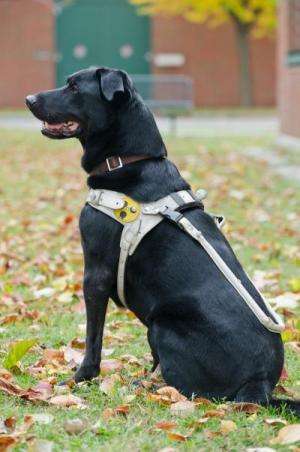Under preassure—A harness for guide dogs must suit both dog and owner

A guide dog communicates with a blind person via a harness and its handle. Researchers at the University of Veterinary Medicine, Vienna (Vetmeduni Vienna) have investigated for the first time the forces guide dogs are exposed to during their work. Physiotherapists and movement analysts compared three types of harness to find which is best for the dog and the owner. The results were recently published in the Veterinary Journal.
Guide dogs lend their eyes to blind people, enabling them to find their way around in an environment they cannot see. Guide dogs require about four years of training and fully trained animals can cost over 30,000 Euro. It is thus important for financial reasons as well as because of animal welfare considerations to ensure that guide dogs are comfortable in their work. A proper harness that enables good communication between the blind person and the dog is an important factor in the animal's well-being, while a poorly fitting harness may result in health problems and impaired communication between dog and owner.
The dog's chest experiences the most tension
Barbara Bockstahler, Christian Peham and colleagues examined the distribution of pressure in working guide dogs by placing pressure sensors beneath the harnesses. Eight guide dogs were filmed with a trainer while climbing steps, avoiding obstacles, turning left and right and walking straight ahead. To visualize the movements, the animals, the trainers and the harnesses were equipped with reflective markers. The positions of the markers were recorded by a total of ten cameras.
The results showed that the bottom right of the animals' chests is particularly stressed. As Bockstahler explains, "Guide dogs walk under constant tension. They are usually on their owners' right and in front of them." The scientists found that the pressure on the right side of a dog's chest may equate to up to 10 per cent of the animal's weight. In contrast, the dog's back experiences far less pressure. "It is important for guide dogs to exercise regularly without a harness to compensate for the lopsided pressure they experience in their work", says Bockstahler.
Flexible harnesses cause less stress
Very rigid harnesses enable quick and finely tuned communication between dogs and owners but cause stress to the animals. The more stiffly the harness is anchored to the handle, the more pressure the animal experiences. The most comfortable harness relies on a hook-and-loop connection, which provides the least pressure on the dog, although for long-haired dogs a plastic clip version is favourable. Rigid metal links are the most stressful for the animals and one of the harnesses tested even restricted the movement of the spine and the front limbs. As Peham notes, "The importance of matching the dog to its owner is well known: the blind person should suit the dog not only in character but also in size. But it seems that the choice of harness is also vital. Flexible and adjustable harnesses, e.g. with telescopic handles, are ideal." Of course, the choice of harness is not always straightforward and Peham is quick to recognize the need to extend the group's research, "We should study guide dogs for a longer period of time to find out whether any of the harnesses are associated with long-term problems in the animals. We are still looking for partners and sponsors for the work".
More information: Veterinary Journal www.sciencedirect.com/science/ … ii/S1090023313004681
Provided by University of Veterinary Medicine -- Vienna



















